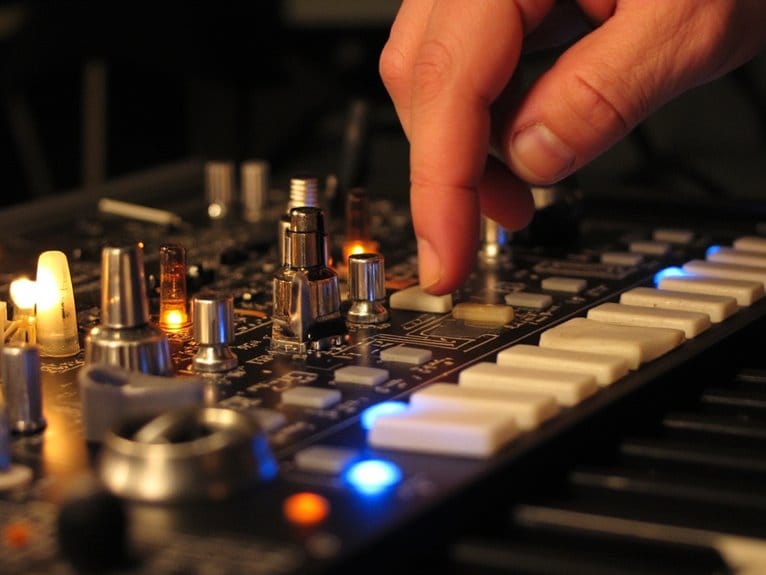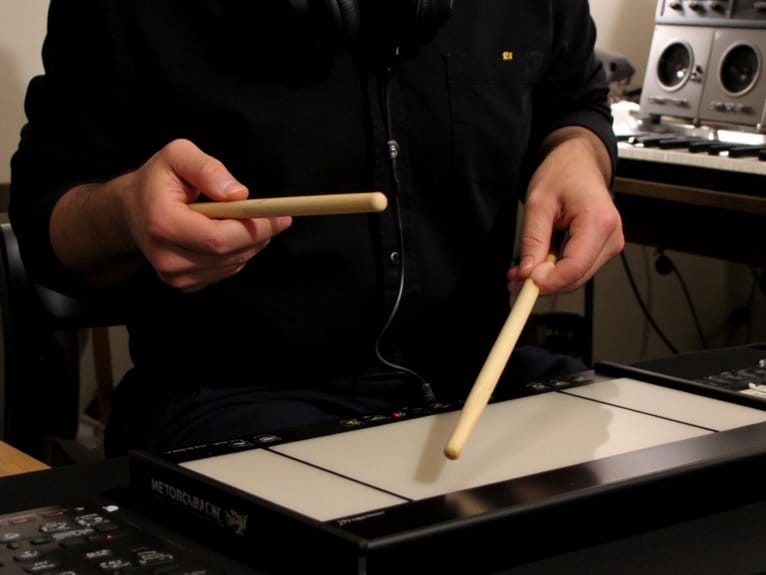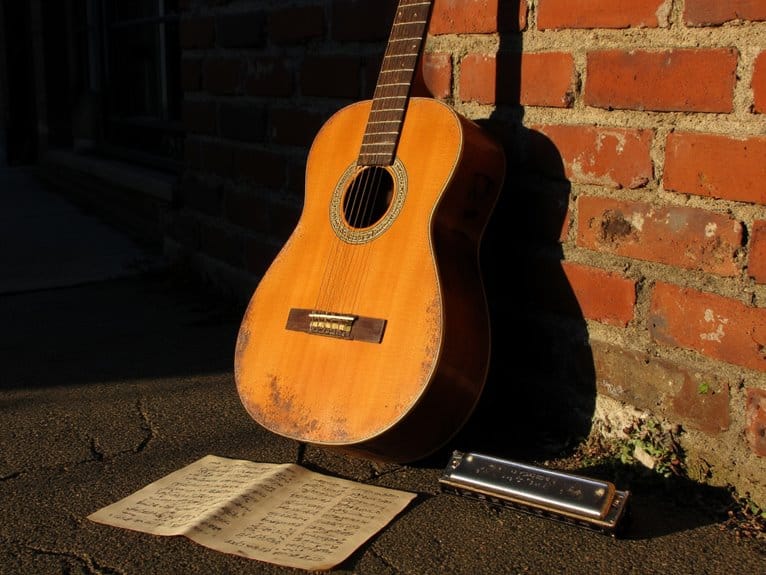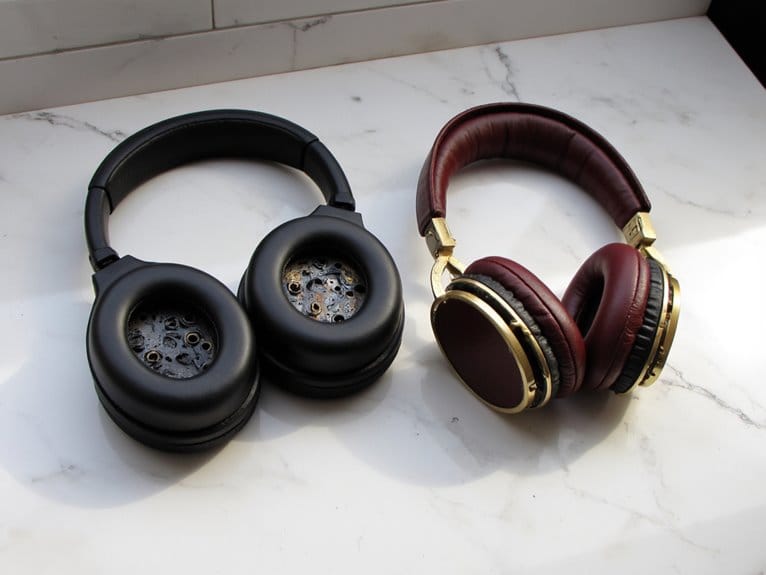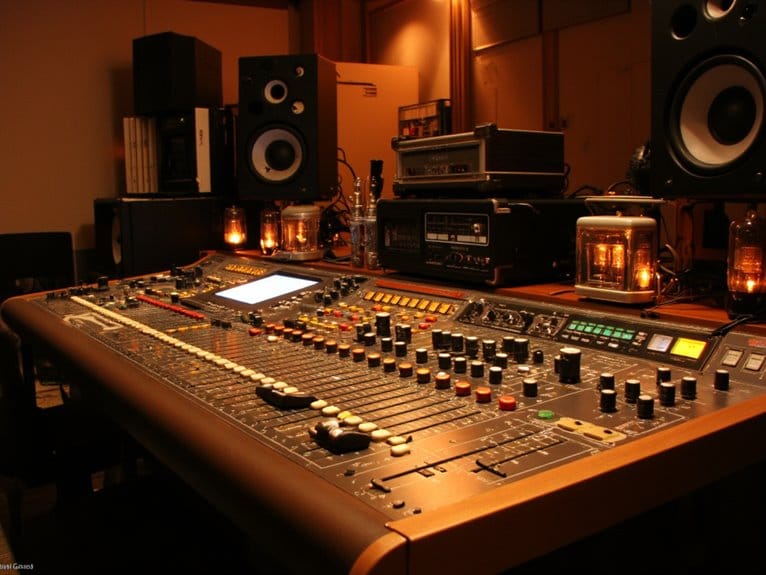Understanding Synthesizer Sampling and Sample Manipulation
Synthesizer sampling lets you capture real instrument recordings and manipulate them through digital techniques like pitch shifting, multisampling across velocity layers, and granular synthesis that breaks sounds into microscopic fragments. You’ll use envelope shaping, precise loop points, and crossfade blending to create seamless playback, while hybrid approaches combine acoustic samples with electronic synthesis for enhanced tonal possibilities. Modern samplers operate at 44.1-48kHz with 16-24 bit depth, balancing audio fidelity against storage requirements—though mastering these fundamentals opens doors to far more sophisticated sound design territories.
We are supported by our audience. When you purchase through links on our site, we may earn an affiliate commission, at no extra cost for you. Learn more.
Notable Insights
- Sample-based synthesis generates sound using digital recordings of real instruments, requiring less processing power than physical modeling or additive synthesis.
- Multisampling records multiple samples across pitch and velocity ranges, using sample zones and layer blending to maintain natural sound quality.
- Proper loop point editing with zero-crossing detection and crossfade techniques prevents clicks and creates seamless, natural-sounding loops.
- Granular synthesis manipulates microscopic sound fragments (1-100ms grains) to create complex textures, with grain size affecting percussive versus atmospheric characteristics.
- Higher bit depths like 24-bit provide greater dynamic range (144 dB vs 96 dB) but require balancing audio fidelity with storage considerations.
Fundamentals of Sample-Based Synthesis
While most synthesizers generate sound through oscillators that create basic waveforms like sawtooth or square waves, sample-based synthesis takes a fundamentally different approach by using actual digital recordings of real instruments, voices, or environmental sounds as its foundation.
You’ll find this method, also called PCM or S&S synthesis, in popular hardware like the Korg M1 and Yamaha Motif series.
When you press a key, the sampler adjusts playback speed to change pitch, which means faster playback raises the note but shortens duration. This technique preserves the original tonal quality completely, making it invaluable for sound design work where authentic instrument reproduction matters more than the synthetic textures you’d get from traditional oscillator-based synthesis methods.
Sample-based synthesis requires lower processing power than physical modeling or additive synthesis, making it an efficient choice for many applications.
To maintain optimal sound quality, samples are typically mapped across a limited note range on the keyboard, preventing extreme pitch alterations that would compromise the natural character of the original recording.
Multisampling Techniques for Realistic Instrument Recreation
Taking multisampling to its logical conclusion means recording dozens, sometimes hundreds of individual samples across an instrument’s entire range and dynamic spectrum, rather than stretching a single recording beyond recognition.
You’ll create sample zones that cover specific pitch ranges, minimizing artificial timbral shifts while capturing authentic sound characteristics at every velocity level. Dynamic ranges become essential here—I’ve found that recording soft, medium, and forte strikes for each key reveals expressive nuances that single samples simply can’t replicate.
Recording multiple velocity layers for each key captures the subtle expressive details that make virtual instruments sound genuinely convincing.
Layer blending between these velocity samples creates seamless shifts, while careful pitch variation limits prevent that unnatural brightness you’d get from excessive stretching.
This approach demands more storage space, admittedly, but the resulting sound authenticity justifies every megabyte when you’re crafting convincing virtual instruments. The flexibility to assign any sound file opens creative possibilities beyond traditional instrument emulation, allowing you to build entirely custom sound banks from field recordings, vocal snippets, or processed audio textures.
Essential Sample Editing and Manipulation Tools
You’ll find that mastering sample editing fundamentals requires three critical skill areas that separate amateur hobbyists from professional sound designers, each demanding its own technical approach and artistic sensibility.
When you’re shaping envelopes, setting precise loop points, and implementing pitch detection algorithms, you’re fundamentally sculpting the DNA of your sampled instruments, determining how they’ll breathe, sustain, and respond across your keyboard’s range.
I’ve spent countless hours refining these techniques, and while the learning curve can feel steep initially, understanding envelope ADSR parameters, zero-crossing loop placement, and formant-preserving pitch analysis will transform your static samples into expressive, playable instruments that rival their acoustic counterparts.
Envelope Shaping Techniques
Since every sample you encounter possesses its own unique sonic fingerprint, envelope shaping serves as your primary tool for sculpting these raw materials into expressive, musical instruments that respond naturally to your playing dynamics.
You’ll find that envelope types extend well beyond basic ADSR configurations, allowing custom shapes and modulation curves that create dynamic expressions impossible with standard controls.
Through careful transient control, you can transform sharp percussive sounds into flowing atmospheric textures, while tonal shaping techniques enable sample evolution from dry recordings into cinematic soundscapes.
I’ve discovered that combining multiple envelope generators creates complex expressive shaping opportunities, where filter cutoffs, pitch modulations, and effect parameters dance together, transforming simple samples into sophisticated instruments that breathe with musical life.
Modern hybrid systems blend digital envelope control with analog sound processing to achieve unprecedented precision in sample manipulation while maintaining the warmth and character of traditional synthesis methods.
Semi-modular synthesizers provide exceptional flexibility for envelope shaping through their patch matrices, often featuring 50-93 connection points that allow complex signal routing between envelope generators, filters, and oscillators.
Budget-conscious producers can explore these envelope techniques using affordable instruments like the 18-voice polyphony Novation MiniNova, which provides extensive customization capabilities for sound design without breaking the bank.
Loop Point Precision
Envelope shaping transforms raw samples into expressive instruments, but without proper loop point precision, even the most sophisticated envelope won’t save you from the jarring clicks and pops that plague poorly edited loops.
Your loop point strategies determine whether sustained sounds flow naturally or sound like broken records, literally. I’ve learned that zero crossing detection places loop boundaries where waveforms cross zero amplitude, minimizing those dreaded loop point artifacts that scream “amateur hour.”
Crossfade looping blends sample endpoints seamlessly, while manual editing lets you fine-tune placements visually. Complex waveforms often resist automated detection, forcing you into painstaking manual adjustment.
Beat-synced points maintain rhythmic consistency, though sampling rate limitations can restrict your precision when positioning those essential loop boundaries.
Pitch Detection Methods
Once you’ve nailed those loop points, pitch detection becomes your next critical battlefield in sample manipulation, where the difference between musical magic and digital disaster often hinges on choosing the right algorithm for your source material.
You’ll encounter three main approaches: time-domain methods like zero-crossing detection offer fast processing but struggle with noise resilience, while frequency-domain techniques using Fourier transforms deliver superior pitch accuracy for harmonic content at the cost of computational overhead.
Hybrid approaches cleverly combine both domains, using linear prediction preprocessing to isolate fundamental frequencies more effectively. Your choice depends on whether you’re prioritizing real-time performance or maximum precision, with windowing strategies affecting the temporal versus frequency resolution trade-offs that ultimately determine your sampler’s musical responsiveness.
Granular Synthesis and Micro-Sample Processing
While traditional sampling grabs entire chunks of audio and plays them back wholesale, granular synthesis takes a fundamentally different approach by slicing source material into microscopic fragments called grains, typically lasting just 1 to 100 milliseconds each.
This texture manipulation technique gives you unprecedented grain control over every aspect of your source material, enabling sample transformation that’s frankly impossible through conventional methods.
You’ll discover that stochastic variation adds unpredictable movement to static samples, while sound layering multiple grains creates rhythmic complexity that evolves naturally over time.
- Grain size determines character: Short grains (1-10ms) produce percussive textures, while longer grains (50-100ms) create smooth, atmospheric sounds
- Density controls thickness: More grains per second build complex sonic textures and rhythmic patterns
- Spatialization creates depth: Position grains across stereo fields for immersive environments
This audio evolution transforms familiar samples into otherworldly soundscapes.
Hybrid Approaches Combining Sampling and Synthesis
Beyond the microscopic world of grain manipulation lies a broader landscape where sampling and traditional synthesis merge into powerful hybrid systems that combine the organic authenticity of recorded audio with the malleable control of synthesized elements. These hybrid techniques offer remarkable creative flexibility, letting you layer acoustic integration with electronic processing for unprecedented texture blending and instrument versatility.
| Hybrid Approach | Primary Benefit | Notable Example |
|---|---|---|
| Linear Arithmetic | Natural attack + synthetic sustain | Roland D-50 |
| Sample + Oscillator | Enhanced harmonic richness | Elektron Digitakt |
| Spectral Resynthesis | Selective frequency manipulation | Kontakt Engine |
| Groovebox Integration | Complete workflow optimization | Roland MC-303 |
Modern hybrid systems enable sound evolution through sample layering with synthesized oscillators, creating complex timbres that pure sampling or synthesis alone can’t achieve.
Technical Standards and Audio Quality Considerations
When you’re working with sampled instruments in your synthesizer, understanding sample rate standards and bit depth becomes essential for achieving professional-quality results, since these technical specifications directly determine how accurately your digital audio captures and reproduces the original sound source.
You’ll find that most modern synthesizers operate at CD-quality 44.1kHz sampling rates with 16-bit depth as a baseline, though professional instruments increasingly use 48kHz or higher rates with 24-bit depth to provide better dynamic range, lower noise floors, and more headroom for processing.
I’ve noticed that while these numbers might seem abstract at first, they translate into very real differences in how detailed, clean, and musically expressive your sampled sounds will be, particularly when you’re layering multiple voices or applying effects processing.
Sample Rate Standards
The foundation of digital audio lies in understanding sample rates, those critical numerical values that determine how many times per second your synthesizer captures and converts analog waveforms into digital data.
Throughout sample rate history, we’ve seen industry standardization around specific frequencies that balance audio quality with practical considerations. When conducting sampling frequency comparison, you’ll notice that 44.1 kHz dominates consumer audio through CD standards, while 48 kHz rules professional video and broadcast applications.
Your choice depends entirely on your intended output medium and workflow requirements:
- 44.1 kHz – Perfect for music production destined for streaming platforms or CD distribution
- 48 kHz – Industry standard for film scoring, broadcast work, and professional video synchronization
- 96 kHz+ – Specialized applications requiring ultrasonic content capture, though they demand considerably more processing power
Bit Depth Impact
Precision becomes everything when you’re dealing with bit depth, that fundamental specification determining how many distinct amplitude values your synthesizer can capture for each individual sample point.
You’ll find that 16-bit provides 65,536 possible values while 24-bit delivers over 16 million, creating considerable bit depth advantages concerning dynamic range and signal-to-noise ratio. When you’re recording at 24-bit, you’re getting 144 dB of dynamic range compared to 96 dB at 16-bit, which means cleaner captures of subtle sonic details.
However, bit depth implications include notably larger file sizes, with 24-bit samples consuming 50% more storage than their 16-bit counterparts, forcing you to balance audio fidelity against practical storage constraints in your production workflow.
Best Practices for Professional Sample Implementation
Professional sample implementation requires a methodical approach that I’ve refined through years of working with both hardware and software samplers, where the difference between amateur and polished results often comes down to attention to seemingly minor details.
Your sample workflow optimization starts with clean editing practices, ensuring precise start/stop points that eliminate unwanted clicks or phase issues during playback. I’ve learned that dividing samples into musical segments enables chromatic playability while maintaining natural shifts between notes.
Clean sample editing with precise start/stop points prevents clicks and enables natural chromatic playability across musical segments.
- Configure envelope controls (ADSR) to match your musical context, using slower attacks for pad-like textures
- Implement granular synthesis parameters strategically, adjusting grain size and jitter for evolving soundscapes
- Organize multiple banks effectively for seamless real time performance techniques during live sets
Proper modulation routing and DSP integration streamline your creative process while reducing external equipment dependencies. Understanding different sound engine types helps determine the character and processing capabilities available for your sample manipulation workflow. When recording samples directly into your sampler, maintaining 24-bit/192kHz recording quality ensures maximum fidelity for subsequent manipulation and processing stages.
Frequently Asked Questions
What Are the Legal Considerations When Sampling Copyrighted Music Recordings?
You’ll need proper licensing agreements from both composition and sound recording copyright holders before sampling. Fair use rarely protects commercial sampling, so unauthorized use risks infringement lawsuits and substantial financial penalties.
Which DAWS Offer the Best Built-In Sampling and Sample Manipulation Features?
You’ll find Ableton Live excels at real-time sample manipulation and warping, while Logic Pro offers extensive built-in tools. FL Studio provides excellent lifetime updates, and Cubase delivers precision editing capabilities for professional sampling workflows.
Can Vintage Hardware Samplers Achieve Sounds Impossible With Modern Software Samplers?
You’ll find vintage hardware samplers create unique sonic character through their hardware limitations – memory constraints, primitive pitch-shifting, and analog circuitry produce distinctive artifacts and textures that modern software can’t authentically replicate.
How Do You Prevent Sample Libraries From Making Your Music Sound Generic?
You’ll prevent generic sounds by extensively processing samples through filters, modulation, and effects. Focus on creative layering of multiple sources and recording your own materials to develop unique sounds that distinguish your music from typical sample library compositions.
On a final note
You’ve now got the essential toolkit for transforming raw samples into polished, professional sounds. Whether you’re layering multisamples, tweaking granular parameters, or blending synthesis methods, remember that practice trumps theory every time. Don’t overthink the technical specs—trust your ears, experiment boldly, and let creativity guide your decisions. Your samples aren’t just audio files anymore; they’re the foundation for your unique sonic signature.

